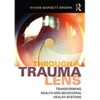Trauma-Informed care represents a major shift in paradigm and practice. It has been defined as a system that realizes the widespread impact of trauma and adverse events, and seeks to actively resist re-traumatization of our clients by changing procedures and practices. Despite the recent calls for trauma-informed care across service sectors, providers continue to ask "What does it look like?" In my recent book, Through a Trauma Lens: Transforming Health and Behavioral Health Systems, I share my first-hand experience and the experiences of a number of organizations that have successfully implemented trauma-informed practice.
Core components of a trauma-informed organization include:
1. A safe and welcoming environment - clients who have been traumatized have an exquisite sensitivity to cues of threat; they are hypervigilant and searching for indications that someone is going to hurt them. Safety has 3 levels: physical, psychological, and cultural. Physical safety includes establishment of a safe environment. It is also important to provide safety for all staff and to ensure that the organization does not repeat adverse/abusive environments.
2. Cultural Safety- This concept offers us one more step to enhance our understanding of the way culture affects our practice. A key principle is the need to recognize that both contemporary and historical inequities affect all our interactions. An essential feature of cultural safety is that the client defines whether or not the practice/provider are culturally safe. We ask the client "Do you feel safe here, with me?"
3. Voice & Choice for Clients - Since trauma imposes loss of control, a trauma-informed approach will focus upon the client having control over aspects of the treatment and being a full partner in treatment decisions (empowerment).
4. Screening - It is recommended that trauma screening be implemented, and I advocate for a trauma-informed introduction: "I'm going to ask you some sensitive questions. If you don't want to answer, please tell me that." If the client states that he/she prefers not to answer a question, that alerts us that the client probably does have a problem with abuse and we should make a note of that. The ACE Questionnaire is one of the screeners recommended.
5. Trauma-Specific Interventions should be available (either on site or through referral) - These interventions (e.g., Seeking Safety, Trauma-CBT) directly address the effects of trauma on the client's life and facilitate recovery by helping the client to understand the connections between the trauma and subsequent feelings and behavior, and teaching coping skills to help him/her regain a sense of control, build more positive and safe relationships, and adopt safer behaviors.
6. Peer Supports - The peer "who has been there" can empathized with a client's fears, as well as educate the client on what to expect in treatment and other services and how to navigate the system. Other unique contributions include: the installation of hope and a relationship characterized by trust. acceptance, and cultural understanding.
7. Training of Staff - Trauma training should be multi-leveled; Every staff member receives basic training on trauma (this includes receptionists, security staff, maintenance staff, etc.). For the staff who will be implementing trauma-specific interventions, there is training on the interventions. There also needs to be training on trauma-informed supervision for supervisors.
8. Self-Care for Staff - Another important component is an awareness that providers may also have experienced trauma. Even if they have not, working with clients who have survived traumatic experiences and listening to their stories can take an emotional toll and lead to secondary trauma. Organizations need to implement a number of actions to help staff including supervision, staff debriefing groups, a calm room where staff can meet or a single staff member can relax or meditate. It is also important that caseloads are held to a reasonable level.




Comments (0)